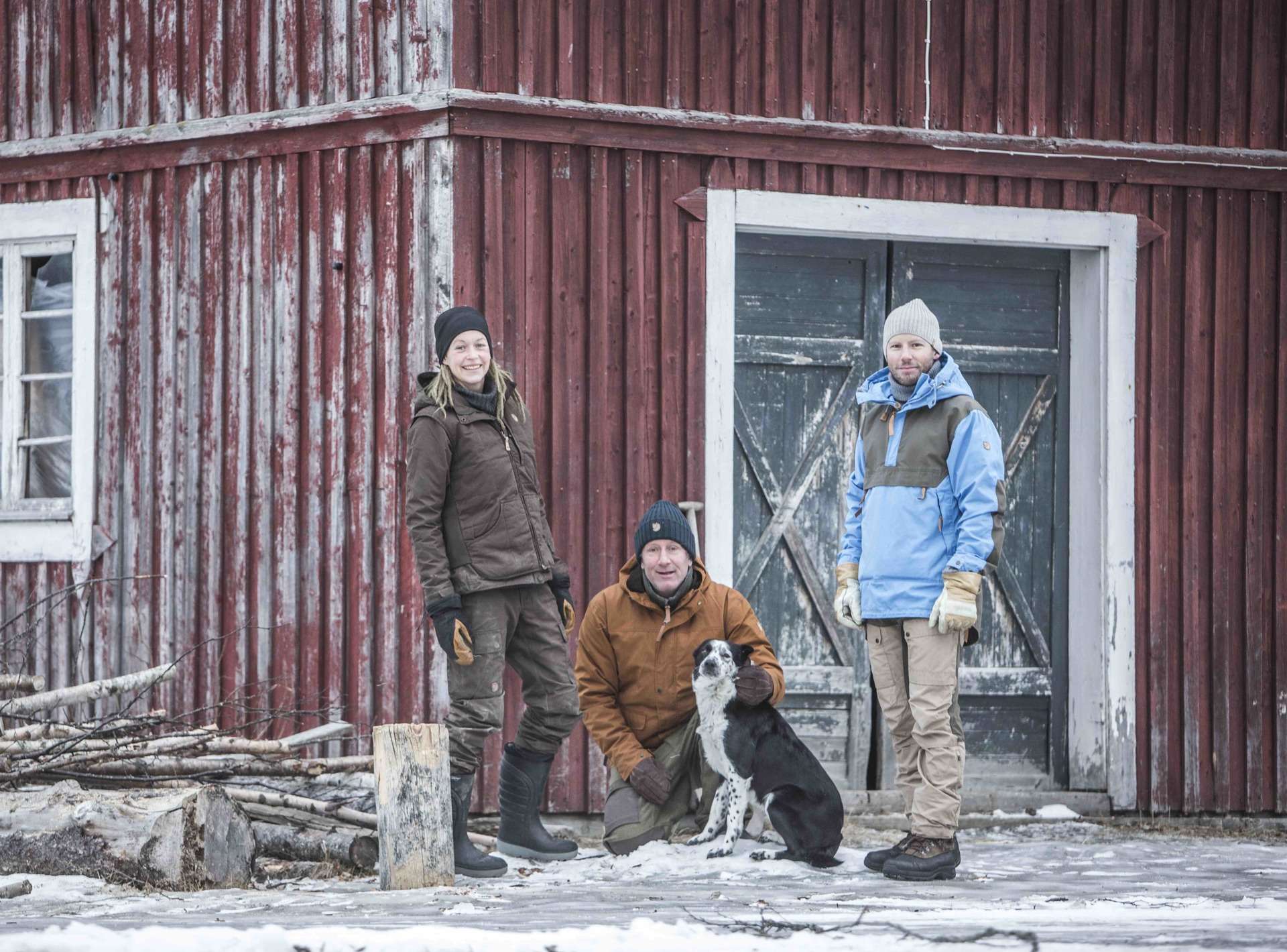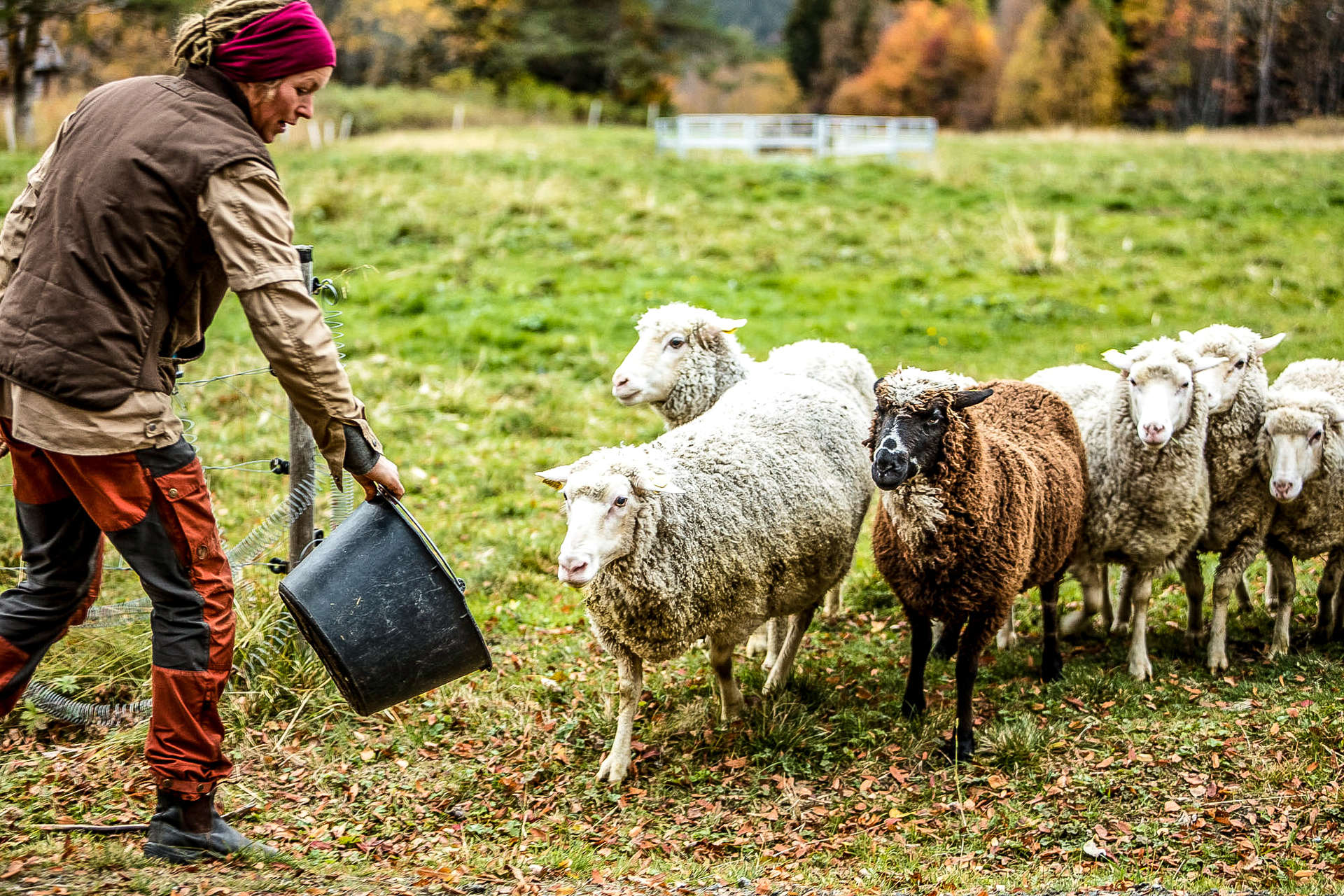Swedish sheep – the journey begins
A multitude of bleats rises to a crescendo. In one pen are half a dozen fluffy sheep, still well endowed with wool. In the other, roughly the same number looking far more slim line. And in the middle: a pile of fluffy white wool. We’re at Brattlandsgården, a farm not far from Sweden’s largest ski resort, Åre, and for most of us – a group of 20 or so Fjällräven employees – this is the first time we’re meeting ‘our’ sheep. And it’s shearing time.
These sheep are the result of 15 months of hard work by Natasha Skott and her family at Brattlandsgården along with a team at Fjällräven, which includes our CEO Martin Axelhed. And these sheep are special. They’re part of a new project that is tasked not only with producing 100% Swedish wool but also producing wool that is 100% traceable.

In recent years we’ve managed to control and guarantee the whole chain of ethically produced down,” says Martin. “Now we want to find a similar solution for wool. We know that wool can be produced sustainably, so now we’re hoping to find out if we can take it to the next level.
To do this, we had to start from scratch. First we had to find the sheep. Because most sheep in Sweden are bred for meat, their wool is not particularly good quality. So the hunt was on, in all parts of Sweden, to find the perfect wool-producing sheep. The answer ended up being right under our noses.
It’s actually really cool. We started off looking at what kind of sheep we actually have in Sweden,” says Christiane Dolva, our sustainability manager. “With most of the traditional sheep breeds, the wool is too coarse and stiff, so it’s more for carpets and that kind of thing. But then Natasha got in touch with a project in Jämtland that had a cross-breed between an old Swedish sheep and a merino sheep and it’s called Jämtlandsfår and it’s registered as a new breed. The wool from that breed is really good and it’s adapted for the Swedish climate.
But it wasn’t just a case of buying a load of Swedish sheep and hoping for the best. Sourcing wool from Sweden isn’t the only aim of this project. In fact, according to Christiane, it isn’t even the most important part.
The most important thing for us is whether we can do everything closer to home with a closer dialogue with the farmer and every step in the supply chain. We’ll learn a lot by doing this, which we’re not able to do in the huge wool supply chain internationally. We expect this will give us insights that we can then use when we go and talk to our other wool suppliers.
And tracing wool right back to the supplier isn’t easy. There is a long chain of suppliers that mean things get a little grey the further back you go. “We’ve often bought wool through yarn manufacturers or even a fabric manufacturer that has contact with a yarn manufacturer, that has contact with a spinner, that has contact with… you get the picture. So since we’re not sourcing it directly from the farm, traceability is an issue,” says Christiane. But with our Swedish wool this will be different.
To be fully ‘made in Sweden’ - if this is even possible - we need to work with Swedish spinners and weaves too. And ideally they should be as close to the farm as possible. But this isn’t easy. The wool industry in Sweden isn’t exactly booming. This may prove to be a problem.
Our first challenge was whether the wool was good enough,” says Christiane, “but once we started testing it, we found it to be such good quality that this wouldn’t be a challenge at all. So the real challenge has proven to be the supply side. There isn’t really a supply chain or infrastructure for wool, at least not on a large scale, here in Sweden. At the moment, while the project is still small, it’s sustainable to have it here in Sweden. There’s a washing and spinning facility close to the farm and we have knitters and weavers in Sweden as well. But as soon as we scale up, which we hope to do, there will be a bottleneck around spinning and washing.

And Christiane reinforces the fact that we are learning. This is a way for us to find out what works and what doesn’t. It’s also a way to take our experience and apply it to our existing methods in order to make them better.
Wool is often traded in an auction kind of way, so the traceability is lost. We’re now challenging our suppliers in terms of how far they can come. That’s the first step. But the second step is, ok if they can come very far down their supply chain, then we will still have a challenge of looking at the animals’ welfare on so many farms. So there we have to at some point decide whether we want to work with existing partners and work our way down and set up requirements or whether we want to choose different international partners. There are initiatives out there that have traceability all the way down to farm level and that have started to work with this responsible wool standard to get certified. So that’s an option.
Animal welfare is a high priority for us and it's part and parcel of this project. Our sheep look happy. They’re able to wander around, grazing wherever the grass is greenest during the summer and sleeping indoors during the cold Åre winter nights. This freedom is afforded them by Natasha’s commitment to holistic management.

This means all decisions are made according to the operating areas on the farm working together,” explains Natasha. “We want to contribute towards a better environment and a better climate.
And because the sheep graze freely, grain doesn’t have to be grown to feed them, which almost totally removes the need for machines and fossil fuels. Seeing holistic management in action, watching the lambs boisterously play with each other, made us proud to be Fjällräven employees.
The lambs have now had their first shearing and we’ve collected a whole load of wool. This will be cleaned, spun and finally woven into garments that you’ll be able to buy in the future. It marks a key chapter in our journey to producing products from Swedish wool, traceable all the way to the source. And what a ‘source’. Our weekend in Åre was so much more than a face-to-face meet with our sheep. It reminded us of why we do what we do. Why it’s so important to create products that are in sync with the environment, that contribute to a better planet. Because this planet is so worth protecting and preserving.
This is just the start. Our journey continues with washing, spinning and knitting. And we want you to follow this journey, right here on the Foxtrail.
Greenland re-visited
Climate change is the “biggest question of our generation”. And Greenland is feeling its effects acutely.
What sustainability means to us
Sustainability is a core principle at Fjällräven. Find out how we balance today’s needs with those of the future.
Expedition Series: Down or synthetic?
Need help deciding between down and synthetic insulation in your Expedition Jacket? This is for you:
